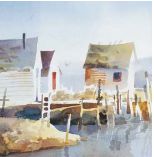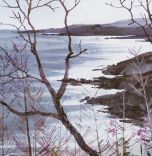Watercolour
Tips and Tricks

Collection of Willa McNeill
Zoltan Szabo

Contents










Introduction
It is my hope and desire that this book will help to further the technical advancement of young watercolor artists. I use the term young intentionally because age has nothing to do with experience or attitude. If you are a freshman watercolorist, you are young even if you happen to be a senior citizen.
In any endeavor, knowledge combined with experience and tenacity is the key to success. Knowledge about watercolor is readily attainable through study. Throughout the following pages I will show you how easy it is to paint watercolor after you have familiarized yourself with just a few techniques. This collection of techniques is based on solutions to problems that have confronted most of my students during my thirty years of teaching watercolor workshops.
Watercolor pigments
A common mystery to the vast majority of students is the nature of transparent watercolor pigments. In this book I include a chapter designed to shed light on the subject and dispel most of the confusion.
Design
Another area in which students are often lacking is a simple and basic knowledge of design. Unfortunately, this subject sounds very scientific, which translates into no fun. This does not have to be true. In the chapter on composition and design, I explain some simple and easy-to-use principles that will creatively spark your design awareness.
Reflections
I find that many watercolorists paint water because they love this beautiful and intriguing subject. However, when it comes to painting reflections on the water, they get flustered and sometimes discouraged because they are not familiar with the physical laws of reflection. Even those artists who take license and paint a strongly abstracted design will paint a more convincing painting if the reflections feel right. To a representational artist, this knowledge is essential. My chapter on reflections comes to the rescue, should you need any help with this subject.

Low Tide
13 17 (34cm 44cm)
Collection of David and Bonnie Hauck
Popular Techniques
Because the technical behavior of watercolor is so varied, I have included many quick watercolor sketches to show you some of the most exciting and popular techniques that I use in my paintings. These examples, on pages 46 to 107, are not finished paintings but small informative sketches to explain particular technical points. You are free to copy them. They will also help you make sure that the tools you choose will behave well in your hands. In other words, I want you to master these techniques in the shortest possible time and enjoy the experience while you are learning.
Demonstrations
The last section in this book shows you many of the above principles and pointers applied in actual demonstration paintings. These paintings are shown in progress with step-by-step photographs of the works as they evolve.
I dont claim that everything you need to know about watercolor is in this or any other book. Watercolor is too fickle a medium to be explained so easily. However, I believe that, based on the material in this book, you can quickly reach a high level of technical efficiency. How far you will go with it will depend on your perseverance. Franz Liszt, the great composer and piano virtuoso, said If I dont practice for one day I can tell the difference the next day. If I dont practice for two days my audience can also tell the difference. You dont have to take this literally to be a good watercolorist (unless you want to paint as well as Liszt played the piano). Few people paint every single day. Nevertheless, the more often you paint the easier it gets.
To make this book fun and easy to use, I am presenting the techniques in many short, illustrated sections to allow you to see what Im talking about and to enable you to use this book either as a reference volume or a complete study guide.
Once youve gained the necessary skill, youll be able to express your ideas and visions well enough to share them with the rest of humanity. Then you will invent your own new approaches to watercolor and virtually eliminate problems because you will be able to adjust and correct as you paint.

Light on History
13 17 (34cm 44cm)

Oregon Harbor
11 14 (28cm 37cm)

North Sea Bastion
13 17 (34cm 44cm)
My Favorite Tools
Brushes
I have designed my own slant bristle brushes made from natural firm bristles in a variety of sizes [1" to 4 (25mm to 102mm)], and enjoy using them for rich dark colors. The soft slant brushes [1" (38mm) and 2" (64mm)] are also my own design and are most useful for delicate, light and wet washes. I also use a no. 3 rigger brush and a palette knife. As you probably noticed, all of these tools except the rigger are flat brushes. I prefer them because the corner can be used like a pointed round brush, whereas a round brush cannot make a wide stroke to imitate a flat brushstroke.
Papers
My favorite papers are 300-lb. (640gsm) cold-pressed Lanaquarelle (French), 300-lb. (640gsm) cold-pressed Arches (French), and my newest treasured discovery is Noblesse (from Holland) made by Papierfabriek Shut Bv.
I use 300-lb. (640gsm) weights strictly for convenience, because heavy papers dont buckle like thinner ones when they are wet. But heavy papers soak up more paint than the thin ones, so you have to compensate for the loss of color by painting a little richer.




























